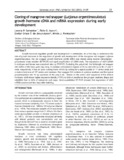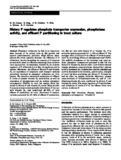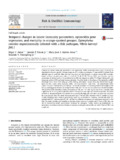Differential expression of insulin-like growth factor I and II mRNAs during embryogenesis and early larval development in rabbitfish, Siganus guttatus
- Global styles
- MLA
- Vancouver
- Elsevier - Harvard
- APA
- Help

View/
Date
2002Author
Page views
1,555ASFA keyword
AGROVOC keyword
Metadata
Show full item record
Share
Abstract
In rodents, the expression of insulin-like growth factor II (IGF-II) is higher than that of insulin-like growth factor I (IGF-I) during fetal life while the reverse is true after birth. We wanted to examine whether this is also true in fish and whether IGF-I and IGF-II are differentially regulated during different stages of embryogenesis and early larval development in rabbitfish. We first cloned the cDNAs of rabbitfish IGF-I and IGF-II from the liver. Rabbitfish IGF-I has an open reading frame of 558 bp that codes for a signal peptide of 44 amino acids (aa), a mature protein of 68 aa, and a single form of E domain of 74 aa. Rabbitfish IGF-II, on the other hand, has an open reading frame of 645 bp that codes for a signal peptide of 47 aa, a mature protein of 70 aa, and an E domain of 98 aa. On the amino acid level, rabbitfish IGF-I shares 68% similarity with IGF-II. We then examined the relative expression of the two IGFs in unfertilized eggs, during different stages of embryogenesis, and in early larval stages of rabbitfish by a semiquantitative reverse transcription-polymerase chain reaction. Primers that amplify the mature peptide region of both IGFs were used and PCR for both peptides was done simultaneously, with identical PCR conditions for both. The identity of the PCR products was confirmed by direct sequencing. Contrary to published reports for seabream and rainbow trout, IGF-I mRNA was not detected in rabbitfish unfertilized eggs; it was first expressed in larvae soon after hatching. IGF-II mRNA, however, was expressed in unfertilized eggs, albeit weakly, and was already strongly expressed during the cleavage stage. mRNAs for both peptides were strongly expressed in the larvae, although IGF-II mRNA expression was higher than IGF-I expression.
Suggested Citation
Ayson, F. G., de Jesus, E. G. T., Moriyama, S., Hyodo, S., Funkenstein, B., Gertler, A., & Kawauchi, H. (2002). Differential expression of insulin-like growth factor I and II mRNAs during embryogenesis and early larval development in rabbitfish, Siganus guttatus. General and Comparative Endocrinology , 126(2), 165-174. https://doi.org/10.1006/gcen.2002.7788
Type
ArticleISSN
0016-6480Collections
- Journal Articles [1258]
Related items
Showing items related by title, author, creator and subject.
-
Cloning of mangrove red snapper (Lutjanus argentimaculatus) growth hormone cDNA and mRNA expression during early development
Samentar, Lorena P.; Ayson, Felix G.; de Jesus-Ayson, Evelyn Grace T.; Formacion, Minda J. (University of the Philippines Visayas, 2013)Growth hormone regulates growth and development in vertebrates. As a first step to understand the role of growth hormone in the regulation of growth and development of the mangrove red snapper Lutjanus argentimaculatus, ... -
Dietary P regulates phosphate transporter expression, phosphatase activity, and effluent P partitioning in trout culture
Coloso, R. M.; King, K.; Fletcher, J. W.; Weis, P.; Werner, A.; Ferraris, R. P. (Springer Verlag, 2003)Phosphate utilization by fish is an important issue because of its critical roles in fish growth and aquatic environmental pollution. High dietary phosphorus (P) levels typically decrease the efficiency of P utilization, ... -
Temporal changes in innate immunity parameters, epinecidin gene expression, and mortality in orange-spotted grouper, Epinephelus coioides experimentally infected with a fish pathogen, Vibrio harveyi JML1
Amar, Edgar C. ; Faisan, Joseph P., Jr.
; Faisan, Joseph P., Jr.  ; Apines-Amar, Mary Jane S.; Pakingking, Rolando V., Jr.
; Apines-Amar, Mary Jane S.; Pakingking, Rolando V., Jr.  (Elsevier, 2017)
Changes in innate immunity parameters and epinecidin mRNA transcript levels were examined to characterize the non-specific immune response of E. coioides to pathogenic V. harveyi JML1 isolated from affected cage-cultured ...
(Elsevier, 2017)
Changes in innate immunity parameters and epinecidin mRNA transcript levels were examined to characterize the non-specific immune response of E. coioides to pathogenic V. harveyi JML1 isolated from affected cage-cultured ...




